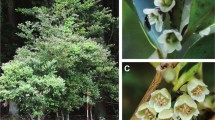Abstract
Floral traits that increase attractiveness to pollinators are predicted to evolve through selection on male function rather than on female function. To determine the importance of male-biased selection in dioecious Wurmbea dioica, we examined sexual dimorphism in flower size and number and the effects of these traits on pollinator visitation and reproductive success of male and female plants. Males produced more and larger flowers than did females. Bees and butterflies responded to this dimorphism and visited males more frequently than females, although flies did not differentiate between the sexes. Within sexes, insect pollinators made more visits to and visited more flowers on plants with many flowers. However, visits per flower did not vary with flower number, indicating that visitation was proportional to the number of flowers per plant. When flower number was experimentally held constant, visitation increased with flower size under sunny but not overcast conditions. Flower size but not number affected pollen removal per flower in males and deposition in females. In males, pollen removal increased with flower size 3 days after flowers opened, but not after 6 days when 98% of pollen was removed. Males with larger flowers therefore, may have higher fitness not because pollen removal is more complete, but because pollen is removed more rapidly providing opportunities to pre-empt ovules. In females, pollen deposition increased with flower size 3 days but not 6 days after flowers opened. At both times, deposition exceeded ovule production by four-fold or more, and for 2 years seed production was not limited by pollen. Flower size had no effect on seed production per plant and was negatively related to percent seed set, implying a tradeoff between allocation to attraction and reproductive success. This indicates that larger flower size in females is unlikely to increase fitness. In both sexes, gamete production was positively correlated with flower size. In males, greater pollen production would increase the advantage of large flowers, but in females more ovules may represent a resource cost. Selection to increase flower size and number in W. dioica has probably occurred through male rather than female function.
Similar content being viewed by others
Author information
Authors and Affiliations
Additional information
Received: 15 June 1997 / Accepted: 12 February 1998
Rights and permissions
About this article
Cite this article
Vaughton, G., Ramsey, M. Floral display, pollinator visitation and reproductive success in the dioecious perennial herb Wurmbea dioica (Liliaceae). Oecologia 115, 93–101 (1998). https://doi.org/10.1007/s004420050495
Issue Date:
DOI: https://doi.org/10.1007/s004420050495




